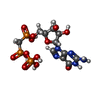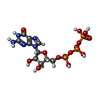+ Open data
Open data
- Basic information
Basic information
| Entry | Database: PDB / ID: 9duq | ||||||
|---|---|---|---|---|---|---|---|
| Title | HURP(65-174) bound to GMPCPP-stabilized microtubule | ||||||
 Components Components |
| ||||||
 Keywords Keywords | CELL CYCLE / microtubule / nucleation / spindle / oncogene | ||||||
| Function / homology |  Function and homology information Function and homology informationmitotic chromosome movement towards spindle pole / signaling / kinetochore assembly / positive regulation of mitotic metaphase/anaphase transition / spindle pole centrosome / Microtubule-dependent trafficking of connexons from Golgi to the plasma membrane / Resolution of Sister Chromatid Cohesion / Hedgehog 'off' state / Cilium Assembly / Intraflagellar transport ...mitotic chromosome movement towards spindle pole / signaling / kinetochore assembly / positive regulation of mitotic metaphase/anaphase transition / spindle pole centrosome / Microtubule-dependent trafficking of connexons from Golgi to the plasma membrane / Resolution of Sister Chromatid Cohesion / Hedgehog 'off' state / Cilium Assembly / Intraflagellar transport / COPI-dependent Golgi-to-ER retrograde traffic / Mitotic Prometaphase / Carboxyterminal post-translational modifications of tubulin / RHOH GTPase cycle / EML4 and NUDC in mitotic spindle formation / Sealing of the nuclear envelope (NE) by ESCRT-III / Kinesins / PKR-mediated signaling / Separation of Sister Chromatids / The role of GTSE1 in G2/M progression after G2 checkpoint / Aggrephagy / RHO GTPases activate IQGAPs / RHO GTPases Activate Formins / HSP90 chaperone cycle for steroid hormone receptors (SHR) in the presence of ligand / MHC class II antigen presentation / Recruitment of NuMA to mitotic centrosomes / NOTCH3 Intracellular Domain Regulates Transcription / centrosome localization / COPI-mediated anterograde transport / regulation of mitotic cell cycle / mitotic spindle organization / chromosome segregation / structural constituent of cytoskeleton / microtubule cytoskeleton organization / neuron migration / mitotic spindle / mitotic cell cycle / microtubule cytoskeleton / microtubule binding / Hydrolases; Acting on acid anhydrides; Acting on GTP to facilitate cellular and subcellular movement / microtubule / GTPase activity / GTP binding / metal ion binding / nucleus / cytoplasm / cytosol Similarity search - Function | ||||||
| Biological species |  Homo sapiens (human) Homo sapiens (human) | ||||||
| Method | ELECTRON MICROSCOPY / single particle reconstruction / cryo EM / Resolution: 2.8 Å | ||||||
 Authors Authors | Ma, M. / Valdez, V. / Petry, S. / Zhang, R. | ||||||
| Funding support |  United States, 1items United States, 1items
| ||||||
 Citation Citation |  Journal: Nat Commun / Year: 2024 Journal: Nat Commun / Year: 2024Title: HURP facilitates spindle assembly by stabilizing microtubules and working synergistically with TPX2. Authors: Venecia Alexandria Valdez / Meisheng Ma / Bernardo Gouveia / Rui Zhang / Sabine Petry /   Abstract: In vertebrate spindles, most microtubules are formed via branching microtubule nucleation, whereby microtubules nucleate along the side of pre-existing microtubules. Hepatoma up-regulated protein ...In vertebrate spindles, most microtubules are formed via branching microtubule nucleation, whereby microtubules nucleate along the side of pre-existing microtubules. Hepatoma up-regulated protein (HURP) is a microtubule-associated protein that has been implicated in spindle assembly, but its mode of action is yet to be defined. In this study, we show that HURP is necessary for RanGTP-induced branching microtubule nucleation in Xenopus egg extract. Specifically, HURP stabilizes the microtubule lattice to promote microtubule formation from γ-TuRC. This function is shifted to promote branching microtubule nucleation through enhanced localization to TPX2 condensates, which form the core of the branch site on microtubules. Lastly, we provide a high-resolution cryo-EM structure of HURP on the microtubule, revealing how HURP binding stabilizes the microtubule lattice. We propose a model in which HURP stabilizes microtubules during their formation, and TPX2 preferentially enriches HURP to microtubules to promote branching microtubule nucleation and thus spindle assembly. | ||||||
| History |
|
- Structure visualization
Structure visualization
| Structure viewer | Molecule:  Molmil Molmil Jmol/JSmol Jmol/JSmol |
|---|
- Downloads & links
Downloads & links
- Download
Download
| PDBx/mmCIF format |  9duq.cif.gz 9duq.cif.gz | 1.5 MB | Display |  PDBx/mmCIF format PDBx/mmCIF format |
|---|---|---|---|---|
| PDB format |  pdb9duq.ent.gz pdb9duq.ent.gz | 1.3 MB | Display |  PDB format PDB format |
| PDBx/mmJSON format |  9duq.json.gz 9duq.json.gz | Tree view |  PDBx/mmJSON format PDBx/mmJSON format | |
| Others |  Other downloads Other downloads |
-Validation report
| Summary document |  9duq_validation.pdf.gz 9duq_validation.pdf.gz | 2.4 MB | Display |  wwPDB validaton report wwPDB validaton report |
|---|---|---|---|---|
| Full document |  9duq_full_validation.pdf.gz 9duq_full_validation.pdf.gz | 2.5 MB | Display | |
| Data in XML |  9duq_validation.xml.gz 9duq_validation.xml.gz | 219.4 KB | Display | |
| Data in CIF |  9duq_validation.cif.gz 9duq_validation.cif.gz | 328.5 KB | Display | |
| Arichive directory |  https://data.pdbj.org/pub/pdb/validation_reports/du/9duq https://data.pdbj.org/pub/pdb/validation_reports/du/9duq ftp://data.pdbj.org/pub/pdb/validation_reports/du/9duq ftp://data.pdbj.org/pub/pdb/validation_reports/du/9duq | HTTPS FTP |
-Related structure data
| Related structure data |  47173MC M: map data used to model this data C: citing same article ( |
|---|---|
| Similar structure data | Similarity search - Function & homology  F&H Search F&H Search |
- Links
Links
- Assembly
Assembly
| Deposited unit | 
|
|---|---|
| 1 |
|
- Components
Components
-Protein/peptide , 1 types, 9 molecules rstuvwxyz
| #1: Protein/peptide | Mass: 5682.775 Da / Num. of mol.: 9 / Fragment: UNP residues 87-132 Source method: isolated from a genetically manipulated source Source: (gene. exp.)  Homo sapiens (human) / Gene: DLGAP5, DLG7, KIAA0008 / Production host: Homo sapiens (human) / Gene: DLGAP5, DLG7, KIAA0008 / Production host:  |
|---|
-Protein , 2 types, 18 molecules BDFHJLNPRACEGIKMOQ
| #2: Protein | Mass: 47940.945 Da / Num. of mol.: 9 / Source method: isolated from a natural source / Source: (natural)  #3: Protein | Mass: 48867.195 Da / Num. of mol.: 9 / Source method: isolated from a natural source / Source: (natural)  |
|---|
-Non-polymers , 3 types, 36 molecules 




| #4: Chemical | ChemComp-G2P / #5: Chemical | ChemComp-MG / #6: Chemical | ChemComp-GTP / |
|---|
-Details
| Has ligand of interest | N |
|---|---|
| Has protein modification | N |
-Experimental details
-Experiment
| Experiment | Method: ELECTRON MICROSCOPY |
|---|---|
| EM experiment | Aggregation state: FILAMENT / 3D reconstruction method: single particle reconstruction |
- Sample preparation
Sample preparation
| Component | Name: HURP(65-174) bound to GMPCPP-stabilized microtubule / Type: COMPLEX / Entity ID: #1-#3 / Source: MULTIPLE SOURCES |
|---|---|
| Molecular weight | Experimental value: NO |
| Source (natural) | Organism:  |
| Source (recombinant) | Organism:  |
| Buffer solution | pH: 6.8 Details: BRB80 (1X): 80 mM PIPES, 1 mM MgCl2, 1 mM EGTA, pH 6.8 with KOH |
| Specimen | Embedding applied: NO / Shadowing applied: NO / Staining applied: NO / Vitrification applied: YES |
| Specimen support | Grid material: COPPER / Grid mesh size: 300 divisions/in. / Grid type: C-flat-1.2/1.3 |
| Vitrification | Instrument: FEI VITROBOT MARK IV / Cryogen name: ETHANE / Humidity: 95 % / Chamber temperature: 298.15 K |
- Electron microscopy imaging
Electron microscopy imaging
| Experimental equipment |  Model: Titan Krios / Image courtesy: FEI Company |
|---|---|
| Microscopy | Model: TFS KRIOS |
| Electron gun | Electron source:  FIELD EMISSION GUN / Accelerating voltage: 300 kV / Illumination mode: FLOOD BEAM FIELD EMISSION GUN / Accelerating voltage: 300 kV / Illumination mode: FLOOD BEAM |
| Electron lens | Mode: BRIGHT FIELD / Nominal magnification: 81000 X / Nominal defocus max: 2500 nm / Nominal defocus min: 1000 nm / Cs: 0.01 mm / Alignment procedure: ZEMLIN TABLEAU |
| Specimen holder | Cryogen: NITROGEN / Specimen holder model: FEI TITAN KRIOS AUTOGRID HOLDER |
| Image recording | Average exposure time: 9 sec. / Electron dose: 39.6 e/Å2 / Detector mode: COUNTING / Film or detector model: GATAN K2 SUMMIT (4k x 4k) / Num. of grids imaged: 2 / Num. of real images: 1728 |
| Image scans | Width: 3838 / Height: 3710 / Movie frames/image: 30 / Used frames/image: 1-30 |
- Processing
Processing
| EM software |
| ||||||||||||||||||||||||||||||||||||||||
|---|---|---|---|---|---|---|---|---|---|---|---|---|---|---|---|---|---|---|---|---|---|---|---|---|---|---|---|---|---|---|---|---|---|---|---|---|---|---|---|---|---|
| CTF correction | Type: PHASE FLIPPING AND AMPLITUDE CORRECTION | ||||||||||||||||||||||||||||||||||||||||
| Particle selection | Num. of particles selected: 348514 | ||||||||||||||||||||||||||||||||||||||||
| 3D reconstruction | Resolution: 2.8 Å / Resolution method: FSC 0.143 CUT-OFF / Num. of particles: 2936725 / Algorithm: FOURIER SPACE / Num. of class averages: 1 / Symmetry type: POINT | ||||||||||||||||||||||||||||||||||||||||
| Atomic model building | Protocol: BACKBONE TRACE / Space: RECIPROCAL | ||||||||||||||||||||||||||||||||||||||||
| Refine LS restraints |
|
 Movie
Movie Controller
Controller



 PDBj
PDBj






